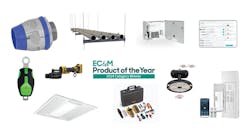Power Quality Training: Its Past, Present, And Future
Feb 1, 1999 12:00 PM, By Ken Michaels, F.D. Hayes Electric Co.
With today's technology, power quality students have many choices. And as more electrical contractors strive to keep up with that technology, many new training methods become viable alternatives to costly classroom instruction.
When it comes to understanding and solving power quality problems, training is the key. There are currently more than 100 power quality courses available through universities, equipment manufacturers, and technical training organizations. But how do you know what medium (classroom instruction, CD-ROM, etc.) is right for you? What knowledge should you expect to gain, and what are the pitfalls?
Classroom training. Many instructors and students still prefer this traditional method because of its interactive advantage. Students can ask questions and get answers during presentation of the material. However, travel costs and time away from work are major drawbacks. In some cases, classroom instruction also leaves many students with unfulfilled expectations. To make sure your training money is well spent, consider the following:
- Read the course outline carefully. Many people who attend power quality training courses often walk away saying: "I could've taught that class." In other cases, many find the information presented obscure or outdated. So before you commit to a class, make sure the majority of the course presentation meets your expectations.
- Beware of courses with more than one instructor. Classes with a single instructor offer consistency. If the course has more than one instructor, and they are not all present at each session, a problem may arise. For example, one power quality training course offered through a university last year had four instructors who presented material over two days. Throughout this class, the instructors continually contradicted each other.
- Look for "hands-on" training. This will give you valuable experience regarding instrumentation, test procedures, and data interpretation.
- Avoid training classes where the presenter has a financial stake in power quality solutions. These courses are often biased and result in glorified sales presentations for a particular product line.
Computer-based training (CBT) courses. You can now take accredited power quality training courses on CD-ROM. One particular training program allows you to learn about different power quality issues as they relate to specific areas of the premises wiring system. The program also permits you to perform power quality surveys where the variables change with every investigation. The advantages of CBT training are:
- It provides the same quality of instruction for each individual accessing the program.
- You can use it as a valuable reference.
- It's more economical than classroom training, although the initial cost may be of some concern.
Internet training. Currently, companies are developing web sites that provide power quality training courses over the Internet. Some of these will be available in the fall of '99. By visiting the site, you'll be given the opportunity to interact, discuss power quality issues in "real time" with a qualified instructor, and take multiple choice quizzes related to a variety of subjects. You'll also be able to receive technology updates and test procedures via e-mail.
Another version of this type of training is Interactive Distance Learning, or IDL. Like Internet training, the only difference is you access the classes through satellite transmission. You can participate with the instructor and other course attendees at remote locations. IDL may ultimately replace the traditional classroom environment because it provides the same quality presentation without the high cost of travel expenses.


